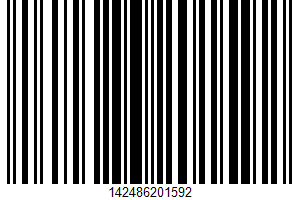Nutrition Bar - 195 calories
Manufacturer Grab 1
Product Information and Ingredients
Nutrition Bar is manufactured by Grab 1 with a suggested serving size of 1 BAR (47 g) and 195 calories per serving. The nutritional value of a suggested serving of nutrition bar includes 0 mg of cholesterol, 0 mg of sodium, 29 grams of carbohydrates, 3 grams of dietary fiber, 11 grams of sugar and 10 grams of proteins.
The product's manufacturer code is UPC: 142486201592.
Calories from fat: a total of 20.77% of the calories in the suggested servig of this product come from fat.
Ingredient List
- Whole Grain Rolled Oats
- Brown Rice Syrup
- Soy Protein Nuggets (soy Protein
- Tapioca Starch
- And Salt); Rice Crisps (rice
- Sugar
- Salt
- Malt Extract); White Chocolate Coating [sugar
- Partially Hydrogenated Vegetable Oils
- (may Contain One Or More Of The Following: Coconut
- Palm Kernel)
- Maltodextrin
- Titanium Dioxide
- Salt
- Artificial Flavor]; Isolated Soy Protein; Honey;corn Fiber; Non Fat Dry Milk; Glycerine; Canola Oil; Fructose; Vanilla Extract;ground Cinnamon; Soy Lecithin & Natural Flavor

Nutrition Facts
Serving Size 1 BAR (47 g)
| Amount Per Serving | ||
|---|---|---|
| Calories 195 | Calories from Fat 41 | |
| % Daily Value* | ||
| Total Fat 4.5g | 3% | |
| Saturated Fat 2g | 5% | |
| Trans Fat 0g | ||
| Cholesterol 0mg | 0% | |
| Sodium 0mg | 0% | |
| Total Carbohydrate 29g | 5% | |
| Dietary Fiber 3g | 6% | |
| Sugars 11g | ||
| Protein 10g | ||
| Vitamin A 1% | Vitamin C 3% |
| Calcium 3% | Iron 9% |
* Percent Daily Values are based on a 2,000 calorie diet.
Nutrition Facts
Serving Size 100g (about 3.52 oz)
| Amount Per Serving | ||
|---|---|---|
| Calories 415 | Calories from Fat 86 | |
| % Daily Value* | ||
| Total Fat 9.6g | 7% | |
| Saturated Fat 4.3g | 10% | |
| Trans Fat 0g | ||
| Cholesterol 0mg | 0% | |
| Sodium 298mg | 6% | |
| Total Carbohydrate 61.7g | 10% | |
| Dietary Fiber 6.4g | 12% | |
| Sugars 23g | ||
| Protein 21g | ||
| Vitamin A 2% | Vitamin C 6% |
| Calcium 6% | Iron 20% |
* Percent Daily Values are based on a 2,000 calorie diet.
Nutrition Bar Nutritional Value
| Nutrient | Suggested Serving 1 BAR (47 g) | Standard Serving 100g |
|---|---|---|
| Energy | 195 kcal (5%) | 415 kcal (10%) |
| Protein | 10 g (9%) | 21.28 g (20%) |
| Total Lipid (fat) | 4.5 g (3%) | 9.57 g (7%) |
| Carbohydrate, By Difference | 29 g (5%) | 61.7 g (10%) |
| Fiber, Total Dietary | 3 g (6%) | 6.4 g (12%) |
| Sugars, Total | 11 g (21%) | 23.4 g (44%) |
| Calcium, Ca | 80 mg (3%) | 170 mg (6%) |
| Iron, Fe | 3.6 mg (9%) | 7.66 mg (20%) |
| Sodium, Na | 140 mg (3%) | 298 mg (6%) |
| Vitamin C, Total Ascorbic Acid | 3.6 mg (3%) | 7.7 mg (6%) |
| Vitamin A, Iu | 100 IU (1%) | 213 IU (2%) |
| Fatty Acids, Total Saturated | 2 g (5%) | 4.26 g (10%) |
| Fatty Acids, Total Trans | 0 g (0%) | 0 g (0%) |
| Cholesterol | 0 mg (0%) | 0 mg (0%) |
Calories Burn off Time
How long would it take to burn off Grab 1 Nutrition Bar with 195 calories? A brisk walk for 42 minutes, jogging for 20 minutes, or hiking for 33 minutes will help your burn off the calories in nutrition bar.
Burn off time varies based on your weight, physical activity and exercise intensity. The following physical activity table contains an estimated burn off time for a person weighting 154 lbs.
| Physical Activity | Burn Off Time |
|---|---|
| Bicycling - 10 mph or less | 41 minutes |
| Dancing | 35 minutes |
| Golfing | 35 minutes |
| Hiking | 33 minutes |
| Light Gardening | 35 minutes |
| Stretching | 65 minutes |
| Walking - 3.5 mph | 42 minutes |
| Weight Training - light workout | 54 minutes |
| Aerobics | 24 minutes |
| Basketball | 27 minutes |
| Bicycling - 10 mph or more | 20 minutes |
| Running - 5 mph | 20 minutes |
| Swimming | 23 minutes |
| Walking - 4.5 mph | 26 minutes |
| Weight Training - vigorous workout | 27 minutes |
Footnotes
Percent daily values are based on a 2,000 calorie reference diet. Factors like age, gender and level of physical activity may affect your daily required values.
The editorial opinions regarding food value or quality in this website are given without warranty, and are not intended to replace medical advice or a nutritionist guidance.
Dietary Recommendations
A healthy eating pattern that accounts for all foods and beverages within an appropriate calorie level could help achieve and maintain a healthy weight and reduce the risk of chronic disease. Healthy eating habits include the following:
- Vegetables from all subgroups, including dark, green, red and orange vegetables and also beans and peas
- A variety of whole fruits
- Grains with at least half of which are whole grains
- Low or fat free dairy products, including milk, yogurt, cheese and/or fortified soy beverages
- Protein foods, including seafood, lean meats and poultry, eggs and nuts
- Oils with limited amounts of saturated fats and trans fats, added sugars, and sodium
